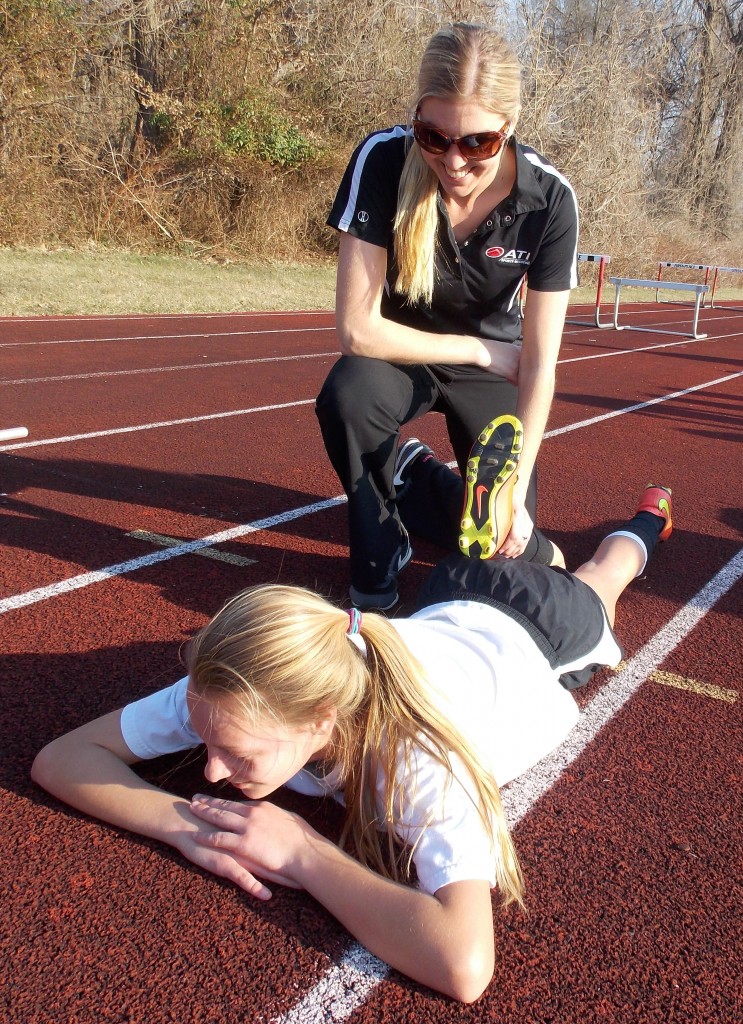
They go mostly unnoticed, which is what they prefer, but athletic trainers keep students ready to perform
The final bell had rung at Archmere Academy, and in the basement of the Moglia Fieldhouse, the athletic training room quickly becomes a hub of activity. The school’s longtime trainer, Jim Malseed, and his assistant, Katie Sturdivant, welcomed a steady stream of Auks waiting to be stretched, taped or otherwise treated.
It’s appropriate that Malseed works in the basement, out of the spotlight, since athletic trainers go mostly unnoticed, which is what they prefer. But in March, National Athletic Training Month, they were very much the focus of attention.

Mandy Costello, the athletic trainer at Ursuline Academy, works with sophomore soccer player Kelsey Olmstead during a recent practice. Stretching is just one aspect of Costello’s job. (The Dialog/Mike Lang)
Injury rehabilitation is a primary component of the job, but there is a lot more to it than that, Malseed said.
“We do the full gamut. Anything they can get going to a PT clinic, they can get here. We also work with the coaches on strength and conditioning programs. We work with the athletic director making sure that the fields are in good shape, things like that,” he said.
Lisa Boyer, who is in her sixth year at Padua Academy, said she spends a lot of time working with athletes and coaches on issues such as hydration, stretching and nutrition. Boyer, a supervisor at ATI Physical Therapy, said there is some misconception about what she does.
“Parents say to me, ‘Do you just get to watch sports all day?’ And I say to them, ‘If I’m just watching the game, you should be so happy because it means that nobody needs me and everybody’s healthy,’” she said.
Boyer oversees the care of more than 300 athletes over the course of a school year. Spring is the busiest, with the number of participants exceeding 150. Padua’s situation presents something of a challenge for her because none of the spring teams practice or play their games on campus or even at the same location.
“I’m a bit unique in that I have 10 minutes [after the final bell rings], and then most of these girls have to be on a bus heading to their fields,” she said. “You get very good at multitasking. It’s like a juggling act. You get very organized at what you do.”
Malseed has been at Archmere for 35 years. He and Sturdivant are something of a rarity in New Castle County because they are staff members at the school. Most schools contract with one of the local physical therapy companies to provide a trainer. The opposite tends to be the case in Kent and Sussex counties, he said.
There are advantages to having the training staff on the payroll.
“The athletic training room is open about eight o’clock,” Malseed said. “School starts about 10 after. If kids have free periods, they come in and get their treatment done then, so either a) if they’re well enough to go back out to practice they go out to practice, or b) at least they can go out and watch and learn what’s going on. They’re not stuck in here.”
The job also has its more perilous aspects, Boyer said. Some injuries are more than a sprained ankle.
“You have a quick time to decide is it safe to move them? Do I call 911? What’s my next step? You’re dealing sometimes with life-and-death situations. You always want to make that right first step because that first step is the most important step,” she said.
Mandy Costello, a trainer with ATI who’s in her sixth year at Ursuline Academy, said National Athletic Training Month is more about educating the public about what they do.
“Sometimes it’s long hours, it’s weekends. We put a lot of time and effort in. We really care a lot about our athletes and care about their care,” she said.
“A lot of time we get, oh you’re a gym teacher, or you’re a trainer so you work people out,” Costello continued. “Yeah, we know how to do that. We could go give our athletes workouts. But it’s more of the prevention of injuries, it’s more of the evaluation of injuries. It’s more of the rehab.”
Although they have their own month, athletic trainers are happy to sit silently on the sidelines, celebrating wins and agonizing over defeats without ever having to slip on a pair of latex gloves. For Boyer, one of her greatest joys at Padua was helping a student come back from a torn anterior cruciate ligament last year as a senior and seeing her contribute to her college basketball team this year. All three trainers have been on the sidelines as their schools won state championships; in fact, Costello watched Ursuline win two titles this winter alone.
“We are an insurance policy,” Malseed said. “We’re standing there and we get the best seats at the game until somebody gets hurt. We hope nobody needs us, but if they need us, we’re there.”